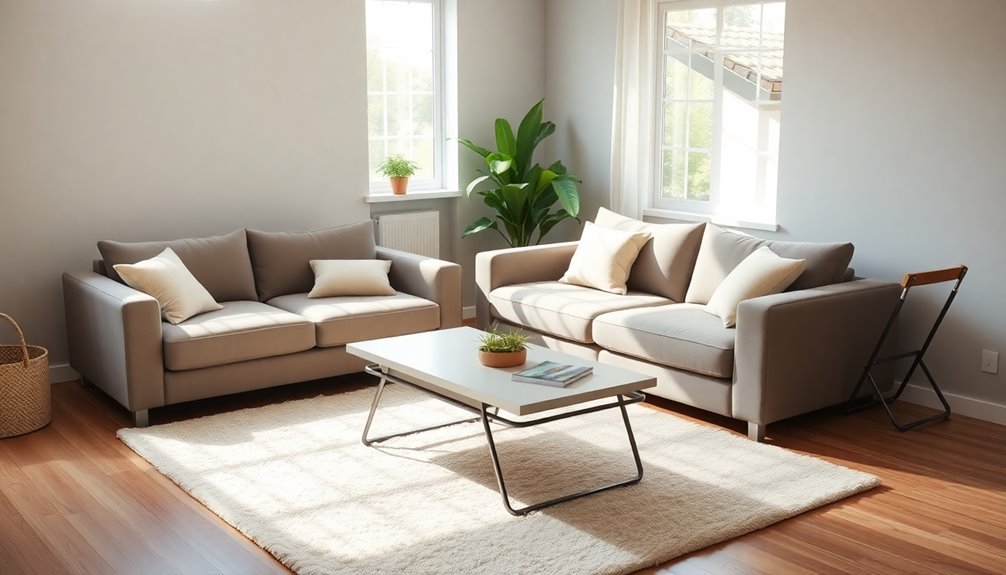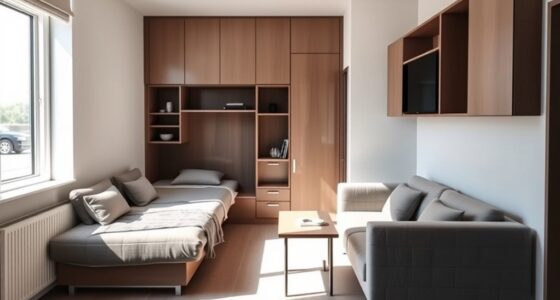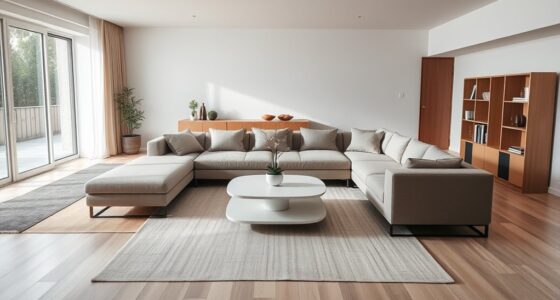If you’re looking for space-saving furniture ideas for small homes with elderly residents, consider multipurpose options like storage ottomans and adjustable tables. These pieces reduce clutter while enhancing comfort and accessibility. Wall-mounted shelves and foldable tables can maximize your space effectively. Don’t forget about smart solutions that cater to safety and independence, like smart home technology. Explore these ideas further to create a functional, inviting living space tailored to your loved one’s needs. In addition, consider incorporating customizable seating arrangements that allow for easy adjustments and mobility, ensuring that your loved ones can move comfortably within their environment. Opting for spacesaving furniture for seniors not only enhances their living area but also promotes a sense of dignity and autonomy. By carefully selecting these items, you can create a warm and accommodating home that fosters independence while appealing to their personal style.
Key Takeaways
- Utilize multipurpose furniture like storage ottomans and extendable tables to maximize functionality without cluttering small spaces.
- Implement wall-mounted shelves and corner storage solutions to keep floors clear and enhance organization for easy access to items.
- Choose adjustable-height tables and ergonomic chairs to accommodate varying mobility needs and provide comfort for elderly residents.
- Incorporate drop-leaf or folding tables that can be easily stored away when not in use, allowing for flexible dining arrangements.
- Use light-colored or reflective materials in furniture design to create an airy and inviting atmosphere in compact living areas.
Understanding the Need for Space-Saving Solutions

As the world's population ages and more people choose to downsize, understanding the need for space-saving solutions becomes essential.
By 2050, over 2 billion people will be 60 and older, often requiring smaller, senior-friendly living spaces. You'll find that efficient use of space enhances mobility and well-being, especially in limited areas. The growing need for senior-friendly spaces emphasizes the importance of adapting our living environments to accommodate an aging population. Additionally, zoning laws can influence the design and layout of these smaller homes to ensure safety and accessibility for elderly residents.
It's crucial to design homes with accessibility in mind, ensuring easy navigation to prevent accidents. Prioritizing functionality and minimizing clutter helps create a safer environment, while effective vertical space utilization can maximize storage without sacrificing floor area.
Embracing these space-saving strategies not only improves your quality of life but also aligns with the global trend of efficient living, making your home both practical and inviting.
Multipurpose Furniture for Enhanced Functionality

When living in a small home, embracing multipurpose furniture can significantly enhance your space's functionality. These innovative pieces maximize your available area, reducing clutter while improving comfort. For elderly residents, accessibility features like lift chairs and adjustable-height tables make maneuvering much easier, creating a home environment that works efficiently. Additionally, incorporating low light office plants can contribute to a calming atmosphere, promoting relaxation and well-being. Plus, modern designs ensure that your functional furniture remains stylish and inviting. Consider practical options like storage ottomans and wall-mounted tables to save space effectively. Additionally, sustainable materials allow you to choose eco-friendly solutions that benefit both your home and the environment.
Compact Dining Solutions for Small Spaces
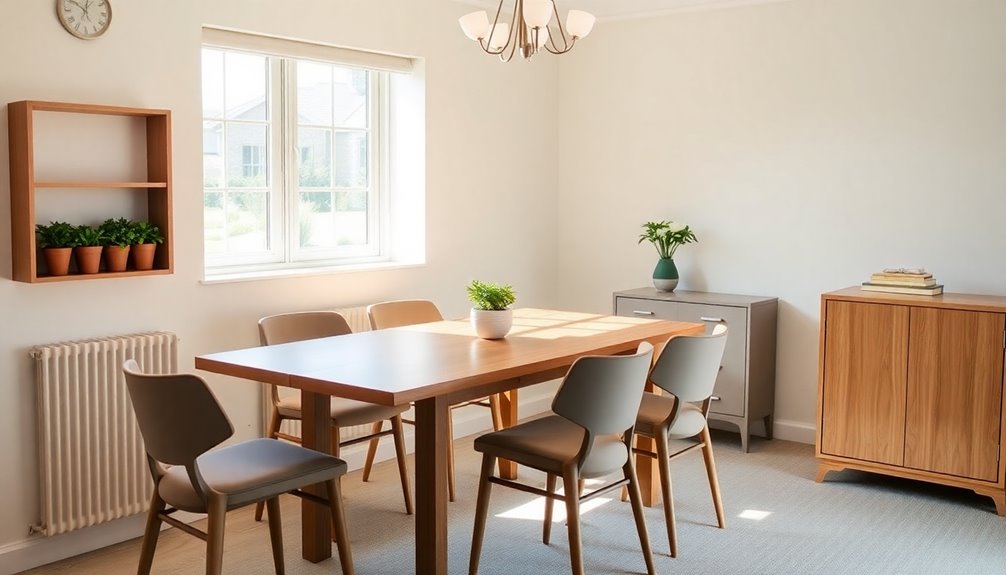
Embracing multipurpose furniture lays a solid foundation for optimizing small living spaces, and compact dining solutions can enhance that functionality even further.
Consider extendable tables that easily expand for guests, or round tables that promote social interaction while fitting snugly in tight corners. Square tables are great for small rooms, while oval tables blend spaciousness with elegance. Round tables are particularly beneficial as they create intimate dining experiences without spatial constraints. Additionally, choosing calming color schemes for your dining area can further enhance the overall ambiance of your small home.
For flexibility, drop-leaf and folding tables can adapt to varying needs and be stored away when not in use. Wall-mounted or portable tables save floor space, and modular designs serve multiple purposes.
Choose light-colored or reflective materials to create an airy feel, and always measure your space to ensure a comfortable dining experience.
Maximizing Storage With Innovative Ideas

To create a more organized and functional living space, maximizing storage is essential, especially in small homes.
Consider utilizing wall shelves to keep floors clear and items accessible. Hanging organizers like hooks can efficiently store coats, bags, and kitchenware. Opt for customizable shelving systems to optimize your wall space. Utilizing vertical space can enhance both functionality and aesthetics in your living areas.
Don't forget about corner storage solutions that make use of often-overlooked areas. Incorporate multifunctional furniture, such as storage ottomans and Murphy beds, to free up floor space.
Utilizing under-bed storage and furniture with built-in compartments will help you keep clutter at bay.
Finally, DIY solutions like repurposed furniture and portable craft carts can transform your home while providing essential storage options.
Aesthetic Enhancements to Create Illusions of Space
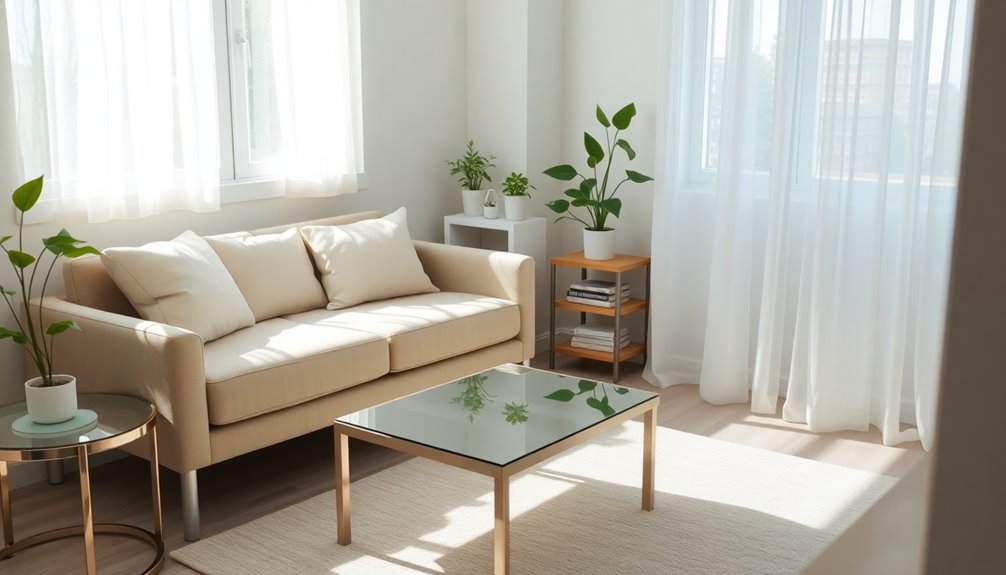
Creating the illusion of space in small homes can significantly enhance your living environment. Start by choosing light color palettes like white, cream, or light gray to foster airiness. Incorporate mirrors to reflect light and create depth, making your rooms feel larger. Consider using transparent materials like glass that allow the eye to travel further. For flooring, opt for larger tiles or a diagonal layout to minimize visual breaks. Keep clutter to a minimum, as this helps maintain openness. Use space-saving furniture with built-in storage compartments to maximize functionality without overwhelming the space, and add vertical elements to draw the eye upwards. With these aesthetic enhancements, your small home can feel more spacious and inviting.
Senior-Friendly Design Considerations
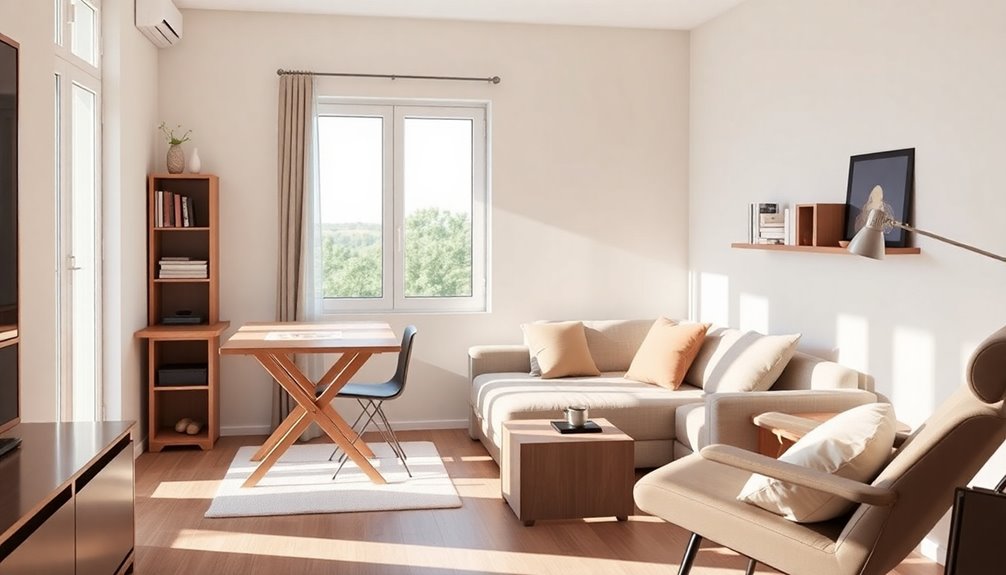
Many small homes can benefit significantly from senior-friendly design considerations that prioritize comfort and safety.
Start by choosing furniture with ergonomic support to accommodate age-related physical changes, ensuring adequate back and leg support. Incorporate adjustable features to meet various mobility needs, and opt for pieces with a solid base to prevent tipping. Good lighting promotes security and helps navigate living spaces safely, making it essential to complement your furniture choices with proper illumination. Additionally, incorporating sensory toys can enhance the overall environment, creating a calming and engaging space for elderly residents.
Easy-to-use controls, like intuitive recliner mechanisms, can make daily tasks simpler. Select comfortable, stain-resistant materials for easy cleaning.
Additionally, consider multi-functional furniture to save space while promoting accessibility. Maintain clear pathways to enhance mobility and reduce hazards.
Future Trends in Space-Saving Furniture
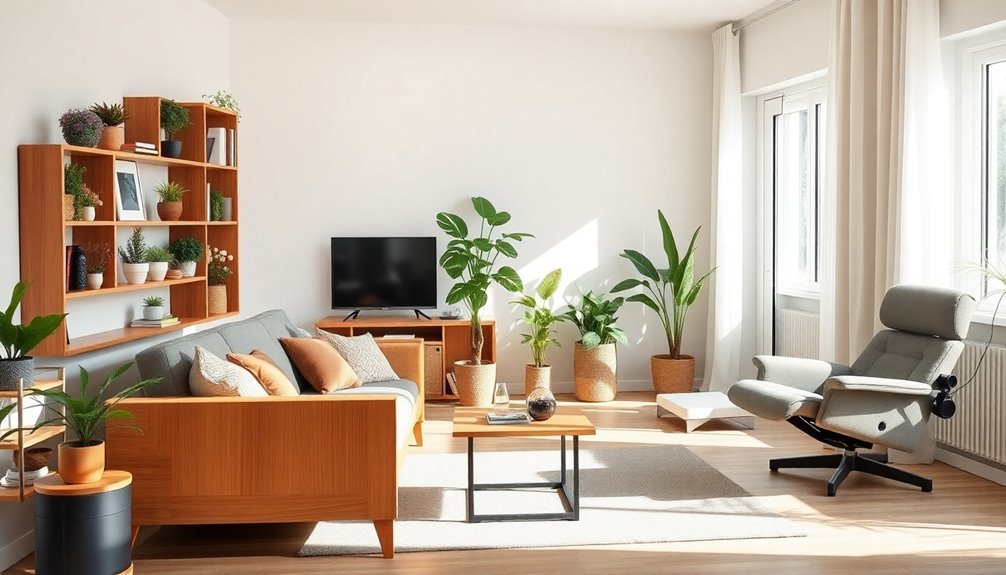
As urban living spaces become increasingly compact, the demand for innovative space-saving furniture is skyrocketing. The small space furniture market is projected to hit USD 6 billion by 2033, driven by urbanization and rising housing costs. AI-driven analysis is playing a crucial role in identifying design trends that meet these needs.
You'll notice a growing preference for multifunctional designs like foldable beds and modular couches, which maximize space without sacrificing comfort. Multi-functional furniture is considered an invaluable asset for modern homes, providing essential solutions for adapting to various needs. Sustainability is also key; lightweight materials like recycled wood and durable steel are becoming standard.
Additionally, furniture that integrates technology, such as built-in charging stations, is on the rise. As you consider your living arrangements, keep an eye on these trends—they're set to redefine how you think about and use your space in the future.
Smart Home Technology for Enhanced Living
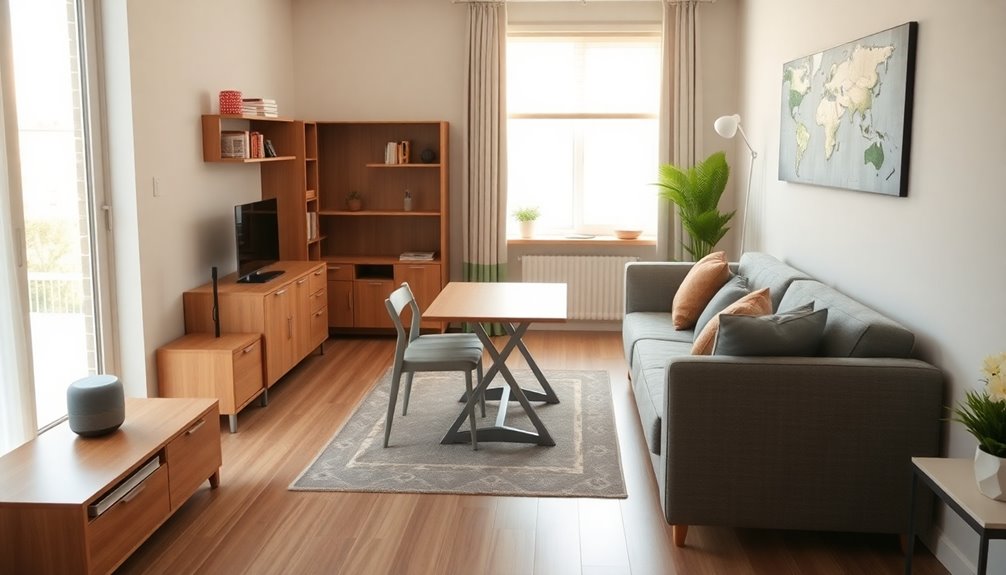
Smart home assistants like Amazon Alexa and Google Home simplify daily tasks with voice control, allowing you to set reminders, play music, and make calls effortlessly. For enhanced safety, these assistants can recognize emergency phrases and alert help when needed. Additionally, incorporating smart home sensors into your living space can detect conditions like smoke and carbon monoxide, further ensuring a safe environment for elderly residents. Moreover, smart utilities can help monitor energy usage, promoting efficiency and comfort in the home.
Smart security systems offer real-time monitoring and doorbell cameras, ensuring you know who's at your door. Plus, medical alert systems and smart medication dispensers help manage health needs effectively. With smart lighting and thermostats, you can create a comfortable environment with minimal effort, promoting convenience and independence in your home.
Customizable Spaces for Changing Needs
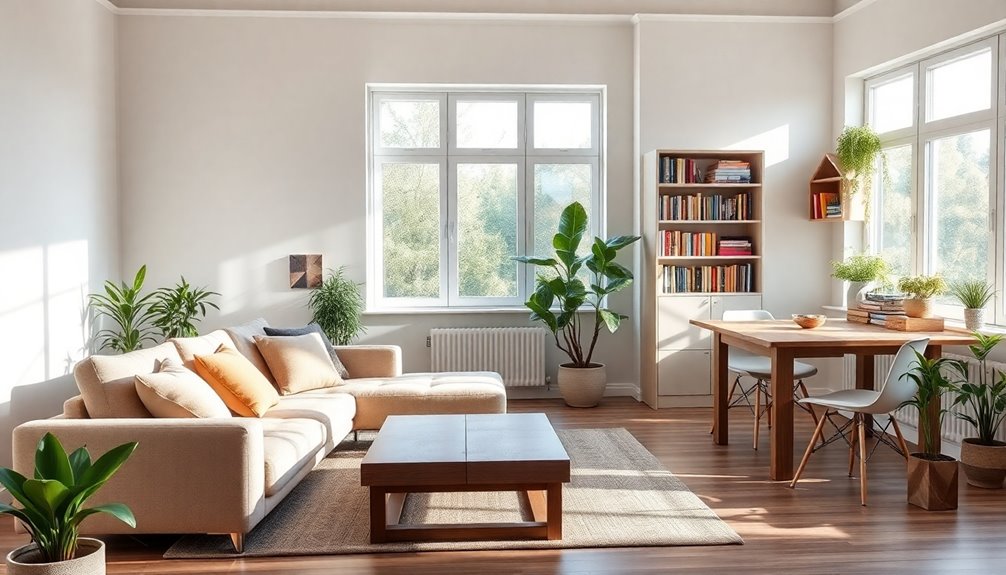
Integrating smart home technology into your living space not only enhances convenience but also sets the stage for creating customizable environments that adapt to your changing needs. Start with thorough health assessments to identify specific challenges your elderly residents face. Tailor spaces based on individual conditions, ensuring adaptability for progressive issues like Parkinson's or osteoporosis. Involve family members in decision-making to align care with expectations. Designing for safety with wider doorways, ramps, and barrier-free showers not only makes mobility easier but also aligns with the increased demand for accessible housing. Additionally, consider incorporating eco-friendly heating solutions like wood stoves, which can provide efficient warmth while supporting sustainable living. Incorporate multipurpose and wall-mounted furniture to maximize space while ensuring comfort with adjustable features. With these personalized plans, you'll foster independence and comfort, creating a nurturing home that evolves alongside its residents.
Choosing the Right Furniture for Your Lifestyle

How can you choose the right furniture that truly fits your lifestyle? Start by aligning your pieces with a cohesive style, whether it's modern minimalism or rustic charm.
Measure your space to ensure each item fits comfortably, leaving room for easy movement. Proportions and scale are essential to consider, as oversized furniture can make small rooms feel cramped.
Think about your daily activities; opt for multi-functional furniture like storage ottomans or extendable tables to maximize utility.
Prioritize comfort in seating and choose durable fabrics, especially if you have pets or kids.
Evaluate materials for quality, aiming for timeless styles that will last.
Finally, visualize your floor plan before purchasing to avoid overcrowding and maintain balance in your home.
Making these thoughtful choices enhances both function and aesthetics.
Frequently Asked Questions
What Materials Are Best for Durable Space-Saving Furniture?
When choosing materials for durable space-saving furniture, you'll want to focus on solid wood for strength and longevity, or engineered wood for stability.
Metal is a great option too, thanks to its versatility and durability.
For comfort, consider high-density foam in cushions and breathable fabrics like cotton.
Lastly, prioritize safety with non-slip coatings and sturdy frames to ensure your furniture remains functional and reliable, even in compact spaces.
How Can I Make My Small Space Feel More Inviting?
Did you know that using light colors can make a room feel 20% larger?
To make your small space feel more inviting, opt for neutral or pastel shades on your walls. Incorporate multi-functional furniture, like storage ottomans, to keep things tidy.
Add plants for warmth and personality, and ensure you have good lighting to brighten the area.
Finally, clear pathways enhance mobility, making your space feel more open and welcoming.
Are There Specific Brands Known for Senior-Friendly Furniture?
Yes, there are several brands known for senior-friendly furniture.
Beaufurn offers functional designs that cater to common areas, while Charter Furniture provides luxury options specifically engineered for seniors.
MityLite specializes in durable, comfortable chairs and tables, perfect for senior living.
Additionally, WeCare Senior Relocation Service can help create senior-friendly spaces, and Greenply features innovative, space-saving furniture solutions.
These brands focus on comfort, accessibility, and style, making them ideal choices for seniors.
What Should I Consider When Arranging Furniture in Small Spaces?
Think of your space as a canvas; every piece of furniture is a brushstroke.
When arranging furniture in small spaces, focus on creating defined zones with floating pieces, ensuring smooth traffic flow around conversation areas.
Choose multi-functional items that serve dual purposes, and consider scale to avoid overwhelming the room.
Don't forget to use vertical storage to maximize space without cluttering the floor, giving your home a more open feel.
How Can I Maintain My Space-Saving Furniture for Longevity?
To maintain your space-saving furniture for longevity, you should choose durable materials like solid wood or metal.
Regularly dust and clean to prevent wear and tear, and adjust your maintenance routine seasonally to address temperature changes.
Promptly repair any minor issues, and condition leather every 6 to 12 months.
Keep your furniture out of direct sunlight, manage humidity levels, and ensure good ventilation to protect against damage and maintain its appearance.
Conclusion
In a world where every square inch counts, you can transform your tiny home into a spacious oasis! With ingenious space-saving furniture, you'll feel like you've unlocked a hidden dimension of comfort and style. Imagine hosting dinner parties in a cozy nook that magically expands to fit a crowd, or a living room that doubles as a yoga studio! Embrace these clever solutions, and watch your small space become a luxurious haven that defies all expectations!
